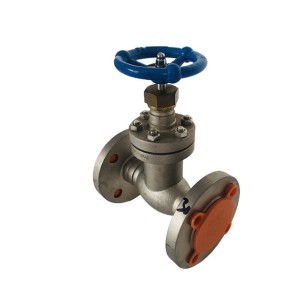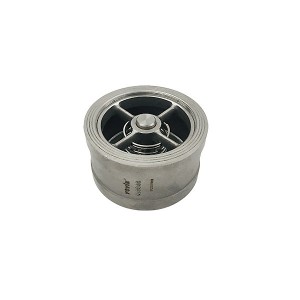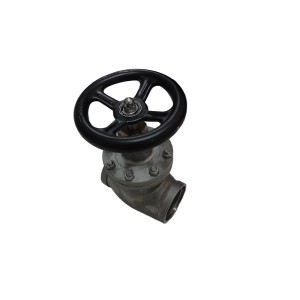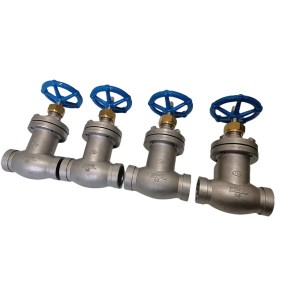In modern power systems, one-way check valves are key safety devices in pipeline systems. Their main function is to prevent medium backflow, protect upstream equipment from damage, and ensure the normal operation of the system. H71H-16C cast steel wafer-type one-way check valve is widely used in various fluid pipelines in power stations, such as cooling water systems, steam systems, etc. However, in actual operation, the valve disc, as the core component of the check valve, has been subjected to fluid pressure, fluid impact, and complex dynamic loads for a long time, and may suffer from fatigue fracture, deformation, and other problems, affecting the safety and reliability of the system.
In order to more accurately evaluate the stress state of the valve disc and improve its structural strength and reliability, this paper will explore the strength optimization of the H71H-16C cast steel wafer-type one-way check valve disc structure based on the fluid-solid coupling analysis method. Fluid-solid coupling analysis can simultaneously consider the mutual influence between fluid flow and structural deformation, more realistically simulate the stress of the valve disc under actual operating conditions, and provide a more reliable basis for structural optimization.

I. Stress analysis and failure mechanism of check valve disc
The loads borne by the check valve disc during operation are complex and diverse, mainly including the following aspects:
1. Fluid pressure:
When the medium flows forward, the fluid pressure acts on the disc to open it. When the medium stops flowing or flows back, the fluid pressure acts on the disc to close it. In the case of high system pressure, this static pressure puts forward basic requirements for the strength of the disc.
2. Fluid impact force:
During the flow of fluid, due to changes in fluid velocity, valve switching action, etc., the disc will be affected by fluid impact force. This impact force is transient and has certain dynamic characteristics, which has an important impact on the local stress distribution and fatigue life of the disc.
3. Inertial force:
The disc will generate inertial force during the opening and closing process. Especially in the case of high flow rate or high medium density, the inertial force of the disc is also a factor that cannot be ignored for structural strength.
4. Turbulent pulsating pressure:
During fluid flow, turbulence will occur due to the complexity of pipeline and valve structures. Turbulence will cause pulsation of fluid pressure. This pulsating pressure acts on the valve disc, which may cause the valve disc to vibrate, thereby accelerating the fatigue failure of the material.

5. Thermal stress:
In high-temperature medium transportation systems, valve discs are subject to thermal stress. The expansion and contraction of materials caused by temperature changes will produce additional stress, affecting the structural integrity of the valve disc.
Traditional static analysis often finds it difficult to fully consider the coupling effect of the above dynamic loads, especially fluid impact and turbulent pulsating pressure. This may lead to the valve disc having stress beyond the design expectation under certain specific working conditions in actual operation, thereby causing fatigue cracks, deformation and even fracture.
II. Structural strength optimization strategy based on fluid-solid coupling analysis
Fluid-solid coupling analysis can more accurately simulate the interaction between fluid and valve disc by coupling fluid dynamics equations and structural mechanics equations, thereby identifying structural weaknesses and providing a scientific basis for the strength optimization of the valve disc. The following are the main strategies for optimizing the structural strength of the check valve H71H-16C disc based on fluid-solid coupling analysis:
1. Numerical simulation and model establishment:
First, it is necessary to establish the geometric model of the check valve H71H-16C and set the boundary conditions according to the actual working conditions (such as fluid medium, pressure, temperature, flow rate, etc.). Then, the computational fluid dynamics (CFD) software is used to perform numerical simulation of the fluid flow to obtain flow field information, including flow rate, pressure distribution, etc. At the same time, the finite element analysis (FEA) software is used to establish the structural model of the disc.
2. Fluid-solid coupling analysis:
Based on CFD analysis and FEA analysis, the pressure and shear force of the fluid acting on the disc surface are applied to the structural model as loads through the fluid-solid coupling algorithm to perform structural stress analysis and deformation analysis. In this way, the stress distribution and deformation of the disc under actual operating conditions can be obtained more accurately.

3. Structural parameter optimization:
Through fluid-solid coupling analysis, stress concentration areas and weak links in the disc structure can be identified. Based on the analysis results, the structural parameters of the valve disc can be optimized, for example:
Optimize the shape of the valve disc: Changing the geometric shape of the valve disc, such as increasing the fillet radius and optimizing the streamlined design, can reduce fluid resistance and fluid impact, thereby reducing the force on the valve disc.
Adjust the thickness of the valve disc: Properly increasing the thickness of the valve disc in the stress concentration area can improve the local strength and fatigue resistance. However, it should be noted that excessive increase in thickness will increase the weight of the valve disc and may affect its opening and closing sensitivity.
Optimize the connection structure: For the connection structure between the valve disc and the valve body, such as hinges or guide structures, optimizing the design can reduce stress concentration and improve the reliability of the connection.
4. Material selection and improvement:
On the premise of meeting the use requirements, you can consider choosing cast steel materials with higher strength and better toughness. At the same time, the surface of the valve disc can be specially treated, such as surface strengthening or coating treatment, to improve its wear resistance and corrosion resistance, thereby extending its service life.
5. Buffer device design:
Under certain high-pressure and high-speed working conditions, it is possible to consider setting a buffer device, such as a damper or a buffer pad, during the closing process of the valve disc to slow down the impact force between the valve disc and the valve seat, reduce the instantaneous impact load, and protect the valve disc structure.

Through the above optimization strategy, combined with the guidance of fluid-solid coupling analysis, the design of the check valve H71H-16C valve disc can be gradually improved to make its structure more reasonable and stronger, thereby improving its reliability and service life under complex working conditions of power stations.
It is a scientific and effective method to optimize the strength of the valve disc structure of the cast steel wafer-type one-way check valve H71H-16C in power stations based on fluid-solid coupling analysis. By more accurately simulating the interaction between fluid and structure, the stress state of the valve disc can be more comprehensively understood, the weak links of the structure can be identified, and the structural parameter optimization, material selection and buffer device design can be carried out in a targeted manner.
When looking for high-quality, reliable check valves, YOYIK is undoubtedly a choice worth considering. The company specializes in providing a variety of power equipment including steam turbine accessories, and has won wide acclaim for its high-quality products and services. For more information or inquiries, please contact the customer service below:
E-mail: sales@yoyik.com
Tel: +86-838-2226655
Whatsapp: +86-13618105229
Yoyik offers various types of spare parts for steam turbines, generators, boilers in power plants:
gate Z61Y-600LB
circulator pump oil F3V101S6S1C20
hydraulic accumulator NXQ1-L25/33 H
Electric stop valve J965Y-200
Oil gun JZYQ-1600/R
Stop valve J41H-63
stainless steel globe throttle check valve (welded) 25FJ-1.6P
Check valve H14H-16P
Power plant shut-off valves WJ40F3.2P
Stop valve J41W-16C
Hydraulic Motor 105-1028-004
Check valve H40H-40
Supplement and exhaust valve ZP88-16P
NITROGEN CHARGING VALVE with M14 x 1.5 mm thread NXQ-63-F/31.5-H
Stop valve J61Y-100 25
Electric gate valve Z962Y-P5410V ZG20CrMoV
lubrication pump price ALD320-20X2
globe valve symbol KHWJ40F
Check valve H61H-25 A105
Electrohydraulic Servo Valve G761-3033B
Electric butterfly valve D943H-10C
Check valve H61H-16C
MANUAL BALL VALVE Q11F-10P DN25
Hydrogen Two Stage Pressure Regulating valve YQQ-11
VALVE CS941H-16C
EH HP accumulator bladder NXQ-AB-40/20 L
BLADDER NXQA-A10/20-L-EH
Mechanical seal M74N-140
servo motor valve D633-460B
Emergency sealing oil pump HSND280-54
Stop valve J61H-16P
Electric stop valve J965Y-100
Stop valve J41Y-100RL
Shutdown electromagnet DF22025
Post time: Mar-26-2025













